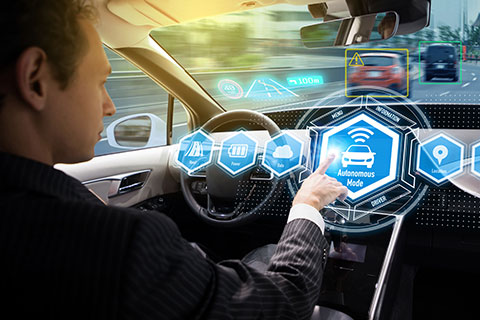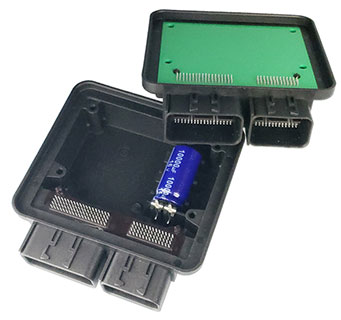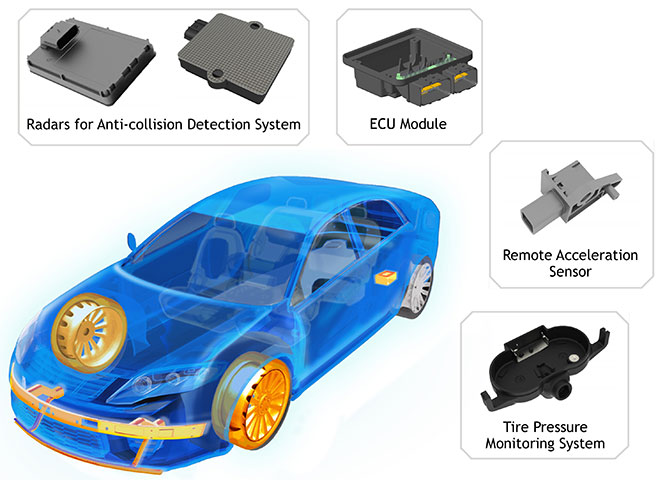ADVANCED MOBILITY
Overview of the Autonomous Vehicle Market
The autonomous or self-driving vehicle market has been predicted to take off for a number of years, and it now appears that the reality is actually starting to catch up with the hype. Many major players have committed significant resources to developing semi-autonomous and fully-autonomous vehicles and a broad ecosystem of enabling technologies has emerged to support these programs.
A variety of prototypes are currently being tested in the R&D centers of automobile companies and universities, with expected launch dates by 2020. According to a report by Market Research Future, the global autonomous vehicles market is expected to reach US $65.3 billion by 2027. Regionally, North America holds the biggest share at 39.08% of the global market and is expected to reach US $24.40 billion by 2027. However, the Asia-pacific region is expected to be the fastest growing segment at 29.02% CAGR from 2016 to 2017 and is anticipated to surpass Europe, which is currently the second largest market region.

Fig 1. Autonomous Driving Vehicles are Gaining Popularity Globally
Anticipated Benefits of Autonomous Vehicles
Proponents of the autonomous vehicle revolution point to a number of benefits that are expected to radically transform our lives. Key payoff areas include increased safety, lower fuel emissions, and more productive use of time for people during their vehicular trips. In commercial areas such as trucking, ride sharing and public transportation, autonomous driving capabilities are projected to increase productivity, reduce costs and improve on-time performance.
Key Enabling Technology Areas
A number of separate technological threads are coming together to make autonomous vehicles a reality. In essence, self-driving vehicles must be able to:
- Know where they are.
- Accurately sense their surroundings in real-time.
- Intelligently integrate multiple streams of data to accurately make on-the-fly decisions and adjustments such as instantaneous braking, acceleration, steering, and so on.
- Communicate with other autonomous vehicles to enable prediction-based driving decisions that improve safety, reduce traffic and reduce need for external controls such as traffic lights.
Some of these critical technology areas include:
Vehicle to Everything (V2X) Communications
Autonomous vehicles cannot operate in a vacuum. The first key to success is hyper-connectivity with virtually everything around them. This includes other vehicles, traffic lights, GPS location data, cloud-based information resources, government hazard warnings, traffic conditions, and essentially any other devices in the growing Internet of Things (IoT) environment. For example, Driver Assisted Truck Platooning (DATP) helps to alleviate driver shortages by enabling a driver to pilot a “lead truck” that is connected with one or more semi-autonomous trucks that follow this leader.
The US Department of Transportation (USDOT) has been researching and testing a variety of connected mobility approaches for vehicles to sense their surroundings and communicate this information to other vehicles, infrastructure, and even personal mobile devices. The top 3 communication targets are Vehicle-to-Vehicle (V2V), Vehicle-to-Infrastructure (V2I) and Vehicle-to-Pedestrian (V2P).
Artificial Intelligence (AI)
A vital element of autonomous driving is the use of Artificial Intelligence, which is the branch of computer science aimed at creating systems that can react and interact with a variety of unexpected situations in much the same way that humans would– but faster and with greater consistency. AI is at the heart of autonomous systems, performing the assessments of multiple information streams and consequently triggering appropriate actions.
Multiple Sensors and Sensor Fusion for Monitoring Road Conditions, Hazards, and Pedestrians
A variety of different types of sensors provide autonomous vehicles with the ability to “see” their surroundings, which is the critical enabling factor for success. Types of sensors for acquiring external data include LiDAR (Light Detection and Ranging), RADAR, ultrasonic and cameras. In addition, internal sensors collect important data on factors such as acceleration, wheel speed, centrifugal forces, and so on.
LiDAR sensors can generally provide more detailed information, but RADAR sensors are significantly less expensive. RADAR is also less impacted by rain, fog or dust, while LiDAR is better at sensing details such as which direction pedestrians are facing. Many manufacturers use a mix of sensor types to get the most complete picture. For example, the new Tesla vehicles combine RADAR sensors with 8 cameras and 12 ultrasonic sensors.
In addition, sensor fusion is an important technology and packaging approach that effectively integrates sensors with Electronic Control Unit (ECU) processors. This tight device-level integration enables smaller, compact devices as well as improved performance and reliability.

Fig 2. New-generation Sensor Fusion ECUs Enable Centralized Processing of Real-time Surrounding Data
Robust On-board Systems are Critical for Success
While the safety, productivity and economic benefits of autonomous driving systems are very attractive, widespread adoption is contingent on their reliability. Vehicular environments are among the most challenging deployment scenarios that developers can face. Some of the key challenges include:
- Ambient temperatures ranging from -40°C to +150°C (SAE Class II-IV)
- Ability to handle constant thermal cycling, vibration and shock
- Ability to interconnect sensors with complex control circuitry
- Capability to embed interconnects within sensors and molded enclosures
- Embedding radiofrequency (RF) shielding to protect signal integrity and reduce interference
The bar is raised even higher when it comes to autonomous driving because of the critical safety issues and the pervasive networking of many sensors throughout the vehicle. The integrity of sensors deployed in bumpers and other external-facing locations is paramount. In addition, communication and integration of data flows from all sensors is of paramount importance.
Vehicle manufacturers need fundamentally solid building blocks, such as sensor fusion within high density ECUs, and molded sensor enclosures with embedded robust interconnects, to turn their ideas on autonomous vehicles into a reality. In addition, they need reliable, cost-effective solutions to support real-time streaming between multiple sensors and centralized autonomous AI functions.

Fig 3. A Variety of Sensor Connectors and ECUs are Required to Support Efficient and Safe Autonomous Driving
Summary
The widespread availability of proven, robust building block solutions is undoubtedly an important factor in bringing down overall implementation costs, shortening development cycles and spurring overall adoption of autonomous systems in the automotive industry.
As the autonomous vehicle revolution continues to accelerate, the key proof points for widespread adoption will fundamentally depend on the willingness of consumers to accept the experience of being driven by a non-human system. In turn, that consumer acceptance will depend on the robust, consistent performance and safety record of the underlying systems.
